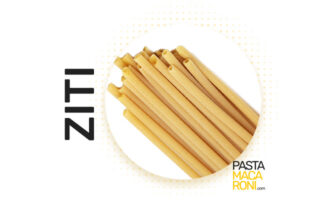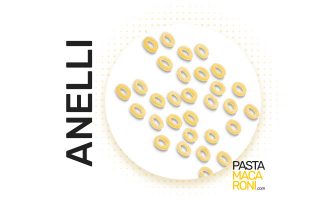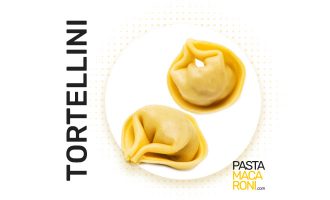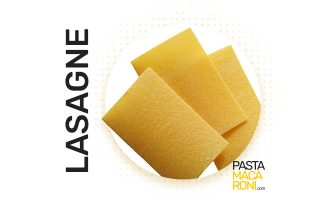Shape – pasta in the form of a square or round dumplings. Size 4-8 cm wide.
Cooking time – 5-8 minutes (until ready).
Ravioli are suitable for any vegetable and meat fillings.
Briefly about Ravioli pasta
Ravioli are a type of pasta that has been around since ancient Rome. They are made by filling a thin layer of pasta dough with various fillings and then sealing the edges to create a small purse-shaped package. They are usually served with various sauces, vegetables and meats, and can also be served in broth as a soup or baked with various toppings. The cooking time for pasta ravioli depends on the size and thickness of the pasta, as well as the type of filling. Ravioli are a good source of complex carbohydrates and contain a moderate amount of protein.
You have come to make delicious Ravioli?
What does Ravioli look like 📏 The shape of Ravioli pasta
Ravioli are usually square, although other shapes are also used, including round and semi-circular. The size is about 4-8 cm.

What is Ravioli | History and Description of the type of pasta
Pasta ravioli is a type of Italian pasta that is made by placing a filling, such as cheese, meat or vegetables, between two layers of pasta dough and sealing the edges to create a shape resembling a pocket or purse. The pasta with the filling is then boiled or baked to perfection. Pasta ravioli come in different sizes and shapes and can be made from different types of dough, such as egg or whole grain. It is a popular dish in Italian cuisine that can be filled with a variety of ingredients, including meat, cheese, vegetables and more.
The earliest known mention of ravioli appears in the 14th century in personal letters of the merchant Francesco di Marco Datini. The mid-14th-century manuscript Libro per cuoco describes ravioli made of green herbs mixed with beaten eggs and fresh cheese, stewed in broth, and seasoned with “sweet and strong spices”.
They were originally made by hand, using a variety of fillings, and were usually served as a luxury item. Today, ravioli are usually made from machine-extruded pasta dough and can be filled with a variety of ingredients.
The analogue of ravioli are dumplings. But unlike dumplings, ravioli, like dumplings, can be a dessert dish with a sweet filling of cottage cheese, berries and fruits.

How to pronounce Ravioli correctly
Ravioli, pronounced [ra-vee-OH-lee].

American and British Pronunciation of Ravioli Sounds like [ra – vee – ow – lee].
What to combine with Ravioli | Serving options and pairings
Pasta ravioli is usually served as a main or first course in Italian cuisine. It can be served plain or with different sauces such as marinara, alfredo or pesto. Other ingredients such as vegetables, meats or cheeses can be added to the dish to create different flavors and textures. Pasta ravioli pasta pairs well with various wines, such as Chianti or Pinot Grigio, as well as with beer or other types of cocktails.
Ravioli are usually boiled and served in light sauces with tomato or basil or simple broths so as not to overpower the flavor of the filling. They go well with butter and olive oil, as well as sauces such as marinara, alfredo or pesto.
Ravioli are traditionally made at home. However, the filling varies depending on the region where they are made. In Rome and Lazio, the filling consists of ricotta cheese, spinach, nutmeg, and black pepper. In Sardinia, ravioli are filled with ricotta and grated lemon zest.

Ravioli Pasta Substitutions
If you can’t find ravioli pasta at your local grocery store or want to try something different, there are several other types of stuffed pasta that can be used as substitutes in ravioli recipes. Some options include agnolotti, tortellini and mezzelune. These pastas are similar in shape and size to ravioli and can be used in recipes in a similar manner.
⏲️ Cooking time | How long to cook Ravioli
- 5 to 8 minutes until ready
- Al dente – 3-5 minutes
Ravioli pasta cooking time depends on the size and thickness of the pasta, as well as the filling and cooking method. Generally, fresh or frozen ravioli with a vegetable or cheese filling should be cooked for 3-6 minutes, or until they float to the surface. Ravioli with meat cook longer, 6 to 10 minutes. Baked ravioli take longer to cook, usually about 20-30 minutes at 350-375 degrees Fahrenheit.
🗒️ Calories and Nutritional Values
- Energy value 1251 kJ / 299 kcal
- Fats 12g
- Carbohydrates 34 g
- Protein 12 g
Nutritional Values (per 100g) – Rana Ravioli 4 Cheese, 250g.
Ravioli pasta is a good source of carbohydrates and protein, and it can be made with a variety of fillings that provide different nutritional benefits. For example, ravioli filled with vegetables or lean meat can be a healthier option compared to ravioli filled with cheese or high-fat meat. However, the nutritional value of ravioli depends on the type of pasta dough used and the additional ingredients that are added to the dish. It is important to read the nutrition labels on packaged ravioli or consider the ingredients used in homemade ravioli to make informed choices about your dietary needs.
🧑🍳 Best recipes with Ravioli – Easy and delicious pasta
Ravioli is a delicious and versatile type of pasta that can be used in a variety of dishes. Their unique purse-like shape and flavorful filling make them popular with pasta lovers. Served with various sauces or in broth and filled with a variety of fillings, ravioli are sure to please everyone at the dinner table.
Are you looking for a delicious and easy dinner idea? Check out pasta ravioli! This classic Italian dish is the perfect way to bring a delicious comfort food to your table. Here are some favorite recipes and tips for making the best pasta ravioli.
Pasta ravioli with ricotta and spinach – a vegetarian recipe
Ingredients:
Pasta dough:
- 1 kg (8 cups) wheat flour
- 8-10 large chicken eggs
Ravioli filling:
- 350g (12 cups) fresh spinach
- 600g (21.16 oz) ricotta
- Water
- 1 egg
- Parmesan cheese
- Nutmeg
Shrimp ravioli – Recipe with cream sauce
Ingredients:
- 7 oz – 200 g ricotta cheese
- 1 whole egg
- The zest of ½ lemon
- 12 cooked shrimp or prawns (7 oz – 200 g)
- A bunch of chives
- Salt and pepper
- Fresh pasta sheets, 2 eggs
- Semolina flour for sprinkles (optional)
Ingredients for cream sauce:
- 1 tbsp. butter
- 2 shallots
- ½ tsp. fennel seeds
- ¾ cup dry white wine
- A few chives
- 2 cups cream
- Salt and pepper
How to Make homemade Meat Filled Ravioli – Cheese & Meat Recipe
Ingredients for ravioli filling:
- 2 tablespoons extra-virgin olive oil
- 2 shallots
- 1 garlic clove, minced
- 3.5 oz – 100 g minced veal
- ½ cup white wine
- 1 bay leaf
- 3.5 oz – 100 g mortadella
- 2 slices of brown bread
- A pinch of milk to moisten bread
- 2 oz – 60 g freshly grated Parmigiano-Reggiano cheese
- 1 tsp. oregano
- 1 large egg
- Salt and pepper
- Marinara Sauce
Ingredients for the pasta:
- 220g wheat flour
- 2 eggs
- 1 egg yolk
Creamy tomato sauce for store-bought ravioli in one pan
Ingredients:
- 1 tbsp. olive oil
- 1 onion
- 2 garlic cloves
- 500 g (1.1 lb) ravioli
- 1 red bell bell pepper
- ½ tsp. Italian herbs
- ½ tsp. chili flakes
- ½ tsp. black pepper
- pinch of salt
- 1 tbsp. tomato puree or pasta
- 90 ml (⅓ cup) white wine
- 100 g (3 ½ oz.) cherry tomatoes
- 120 ml (½ cup) chicken stock
- 90 ml (⅓ cup) cream
- 90 g (3 cups per package) baby spinach
- 50 g (½ cup) grated parmesan
- 1 tablespoon fresh parsley
Transform store-bought ravioli by making this rich and creamy tomato sauce for spinach and parmesan ravioli. You can make this dish in 15 minutes and in just one skillet. The perfect comfort and easy meal for a busy weekday!
You don’t have to use all the ingredients. Cook in a way that makes you feel comfortable.
How to make fresh Ravioli at home
Ravioli is a type of pasta that is made by placing the filling between two layers of pasta dough and sealing the edges. Cooking ravioli at home is a fun and rewarding process that allows you to change the filling and flavor to your liking.
Here’s a step-by-step guide to making ravioli at home:
- First, prepare the pasta dough.
To do this, mix the flour and salt in a large bowl. Make a well in the center and add the eggs. Using your hands or a fork, mix the eggs and flour until a dough forms. If the dough is too dry, add a little water. If it is too wet, add more flour.
- When the dough comes together, transfer it to a floured surface and knead until smooth and elastic, about 10 minutes.
Cover the dough with plastic wrap and let it rest for at least 30 minutes.
- While the dough is resting, prepare the filling for the ravioli.
This can be any combination of ingredients you like, such as cheese, meat, vegetables or herbs. You can also choose one of the recipes on the page.
- Divide the dough into four equal pieces and roll one piece at a time using a rolling pin or pasta machine.
If you are using a pasta machine, start with the widest setting and gradually reduce the width until you get a thin sheet of pasta. Sprinkle the pasta sheet with semolina flour to prevent sticking.
- Spoon the ravioli filling onto the pasta sheet, leaving enough room between spoonfuls to seal the dough.
Cover the filling with the second sheet of pasta dough. Use a rolling pin to lightly press down on the dough, sealing the filling inside.
- Use a ravioli cutter, ravioli stamp, or sharp knife to cut out individual ravioli.
Transfer the ravioli to a baking sheet sprinkled with semolina flour. Repeat the process with the remaining dough and filling.
- At this point, the ravioli can either be cooked immediately or frozen for later use.
- To prepare the ravioli, bring a pot of salted water to a boil and gently lower the ravioli into it.
Cook the ravioli for 3 to 8 minutes, or until they float to the surface. Carefully transfer the cooked ravioli to a serving dish using a small spoon. Serve the ravioli with the sauce of your choice.
How to make fresh RAVIOLI from scratch at homemade pasta – step-by-step video
You can use the video instructions from The Pasta Queen to make handmade fresh ravioli stuffed with a simple ricotta and spinach filling. You’ll also learn how to pair them with a fresh sauce, all in 10 minutes!
Making homemade ravioli is a time-consuming process, but it’s worth it for the delicious and satisfying results. Whether you use a ravioli making machine, a ravioli mold, or just your hands, learning how to make ravioli is a valuable skill that will impress your friends and family. With a little practice and creativity, you can make a wide variety of ravioli dishes using your own fresh pasta dough and combinations of toppings. So why not try and find out how delicious homemade ravioli can be?
How to make ravioli from scratch without a pasta machine
Another version of how to make ravioli from scratch from the Forketti Food Channel.
If you want to know how to make ravioli from scratch, watch this video. This simple recipe includes the dough recipe, the spinach and ricotta filling, and the sauce idea. You don’t have to make the sauce and just serve the ravioli on a plate with fresh basil.
How to Cook Ravioli Pasta
A short video on how to make pasta ravioli with chicken filling and sauce. You will need four quarts of water in a pot to make ravioli pasta.
FAQ about Ravioli pasta
-
Why is ravioli traditional in Italy?
Ravioli have a long history in Italy and are thought to have originated in the northern region of the country. It is believed that ravioli were originally created as a way to use leftover pieces of pasta dough that were filled with various ingredients and then cooked. Over time, ravioli became a popular dish in its own right and is now considered a traditional Italian food.
-
Is ravioli noodles or pasta?
Ravioli is a type of pasta. They are made by filling a thin pasta dough with a filling, such as cheese, vegetables, or meat, and then folding the dough over the filling to form a pocket. The pocket is then sealed by squeezing the edges of the dough together and you get a stuffed pasta dish.
-
What is the difference between tortellini and ravioli?
Tortellini and ravioli are both types of stuffed pasta dishes that originated in Italy. However, there are some differences between them. Ravioli are usually made by filling a thin pasta dough with stuffing and then folding the dough over the stuffing to form a square pocket. The pocket is then sealed by squeezing the edges of the dough together or trimmed with a special knife. Tortellini are initially formed in a crcg of dough, after folding the dough over the filling, this paste looks like little navels. The edges of the dough are then pressed together to seal the filling inside. But otherwise, these are similar types of stuffing pasta that are interchangeable in recipes.
-
What does ravioli filling consist of?
Ravioli fillings can consist of a variety of ingredients, including cheese, vegetables, and meat. Some common ravioli fillings include ricotta cheese, spinach, and ground beef. The filling may also include additional ingredients, such as spices or herbs, to add flavor.
-
What is the traditional filling for ravioli?
A traditional ravioli filling is usually made with cheese, such as ricotta, or a combination of cheese and vegetables, such as spinach and ricotta. Other traditional ravioli fillings may include ground meat, such as ground beef or pork, or a mixture of meat and vegetables. The filling may contain additional ingredients such as spices or herbs.
-
What can I put in my ravioli instead of ricotta?
There are many alternatives to ricotta cheese that can be used as a filling for ravioli. Some options include:
– Other types of cheese, such as mozzarella, parmesan or feta,
– Cooked vegetable puree, such as pumpkin or squash,
– Cooked and shredded meat, such as beef, pork, turkey or lamb,
– Pesto or other flavorful sauces,
– Tofu or other plant-based sources of protein. -
What sauces go well with ravioli pasta?
Ravioli is a versatile pasta dish that pairs well with a variety of sauces. Some classic sauces that go well with ravioli include:
– Tomato sauce
– Alfredo sauce
– Pesto
– Gorgonzola or other blue cheese sauces
– Mushroom or truffle sauce -
What do you traditionally serve ravioli with?
Ravioli is usually served as a main dish, and a variety of side dishes can be served with it. Some traditional ravioli side dishes include:
1) Salad,
2) Bread or garlic bread,
3) Roasted vegetables,
4) Grilled or sautéed meat or seafood,
5) A simple green vegetable, such as steamed broccoli or asparagus. -
What are some creative ways to serve pasta ravioli?
There are many creative ways to serve ravioli pasta. Here are a few ideas:
1) Use ravioli as a salad topping. Simply cut the ravioli into small pieces and toss them into a salad to give it extra texture and flavor.
2) Use ravioli instead of lasagna noodles. Prepare a layered dish with meat or vegetables, sauce and cheese by using ravioli instead of lasagna noodles.
3) Prepare a ravioli soup. Add cooked ravioli to a hearty vegetable or meat broth for a hearty and flavorful soup.
4) Serve the ravioli as an appetizer. Fry or bake pieces of ravioli in oil and serve with dipping sauce.
5) Top the ravioli with a flavorful sauce or pesto. Pour sauce or pesto of fresh herbs, nuts or cheese over the finished ravioli for extra flavor. -
What are the best vegetables to go with ravioli?
Ravioli goes well with a variety of vegetables. Vegetables that go well with ravioli include:
– Spinach,
– Tomatoes,
– Zucchini,
– Eggplant,
– Sweet bell pepper,
– Onion,
– Garlic,
– Carrots.
These vegetables can be cooked in a sauté pan, in a deep fryer, baked or grilled and served with or on top of the ravioli. -
What meats go with ravioli?
Ravioli go well with a variety of meats. Some meats that go well with ravioli include:
– Chicken,
– Beef,
– Pork,
– Lamb,
– Sausage.
You can serve the meat along with the ravioli or use it as a ravioli filling. -
What can you add to ravioli to make it tastier?
There are many ways to add flavor to ravioli. Here are some ideas:
1) Pour a flavorful sauce or pesto over the ravioli. Pour a sauce or pesto of fresh herbs, nuts or cheese over the finished ravioli to give it extra flavor.
2) Add herbs or spices to the ravioli filling or to the sauce you are serving with the ravioli.
3) Use flavored ravioli. There are many varieties of flavored ravioli, such as spinach and feta ravioli, mushrooms or sun-dried tomatoes.
4) Add vegetables to the ravioli filling or to the sauce you serve with the ravioli. Vegetables such as spinach, mushrooms and sun-dried tomatoes add flavor and nutrition to the dish.
5) Sprinkle the ravioli with cheese, such as parmesan or feta, for extra flavor. -
How many ravioli should I serve per person?
The number of ravioli per person depends on the size of the ravioli and the other dishes you are serving. Generally, you should serve 8-12 ravioli per adult for the main course and 6-8 ravioli per person for the side dish.
-
Do I need to cook store-bought ravioli?
Yes, store-bought ravioli usually need to be boiled to cook them properly. To boil the ravioli, bring a pot of salted water to a boil and carefully add the ravioli. Cook the ravioli according to the instructions on the package or until they are tender and fully cooked.
-
Can I fry the ravioli instead of boiling them?
Yes, ravioli can be pan fried instead of boiled. To fry the ravioli, heat a small amount of oil in a frying pan over medium-high heat. Add the ravioli to the pan and cook until they are browned and crispy on both sides. Be sure to cook the ravioli until fully cooked before serving. To test, take one out, pierce it with a fork and taste the filling in the center.
-
How do Italians eat ravioli?
In Italy, ravioli are usually served as a first course, or “primo,” in a traditional Italian meal. They are often served with a simple sauce, such as tomato or meat sauce, or with a little butter and cheese. In some regions of Italy, ravioli are also served as a main course with a side dish, such as salad or vegetables.
-
What does “ravioli” mean in Italian?
The word “ravioli” is of Italian origin and refers to small dumplings made of pasta dough with a variety of fillings, such as cheese, meat or vegetables. The word “ravioli” comes from the Italian word “raviolo,” which means “little turnip.” The name comes from the traditional shape of dumplings, which were originally shaped like little turnips.
-
How to slice ravioli without a knife?
There are several ways to slice ravioli without using a knife:
1) Use kitchen scissors. Place the ravioli on a cutting board and use the kitchen shears to cut the pasta.
2) Use a pizza cutter. Place the ravioli on the cutting board and use a pizza cutter to cut through the pasta.
3) Use a fork. Place the ravioli on a plate and use a fork to press the pasta and divide it into two pieces. -
What are deep-fried ravioli called?
Deep-fried ravioli are commonly called “ravioli fritti” in Italian, which means “fried ravioli.” Sometimes they are also called “crispy ravioli”, “Toasted ravioli”, “T-Ravs” or “deep-fried ravioli.” Deep-fried ravioli is a popular snack in Italian-American cuisine that is usually prepared by deep-frying small, pre-cooked ravioli until they are crispy and golden. It was created and popularized in St. Louis, Missouri, at two restaurants, Mama Campisi’s and Charlie Gitto’s.
-
Is the meat in ravioli raw?
The meat in fresh ravioli is usually cooked before it is used as a filling. A variety of meats can be used as ravioli fillings, such as beef, pork, lamb, or chicken. The meat is usually boiled and then finely chopped or shredded before it is used for the ravioli filling. If you buy store-bought ravioli, read the package before cooking, it should tell you how long to cook the pasta until cooked.
-
Pasta ravioli filling ideas
There are many different filling ideas for ravioli. Here are some creative and flavorful ravioli filling ideas:
1) Cheese and Herbs: Combine different cheeses such as ricotta, parmesan and mozzarella with fresh herbs such as basil and parsley for a simple and flavorful filling.
2) Mushrooms and truffle: Roast a mixture of mushrooms with truffle oil for a rich and savory filling.
3) Zucchini & Sage: Roast zucchini and combine with chopped fresh sage for a sweet and flavorful topping.
4) Spinach and artichoke: Combine cooked spinach and chopped artichoke hearts for a creamy and flavorful topping.
5) Beef with red wine: Prepare ground beef with red wine and herbs for a rich and savory filling. -
Recommendations for Serving Pasta Ravioli
Here are some recommendations for serving ravioli pasta:
– Serve ravioli with a flavorful sauce. Try a tomato or meat sauce, or a simple butter and cheese sauce.
– Sprinkle the ravioli with grated cheese, such as parmesan or pecorino.
– Garnish the ravioli with fresh herbs, such as basil or parsley.
– Serve the ravioli with a side dish of vegetables, such as sautéed spinach or roasted tomatoes.
– Top the ravioli with bread or salad to complete the meal. -
Is ravioli pasta a healthy or unhealthy dish?
Ravioli pasta can be a healthy dish if it is made with whole-grain pasta and filled with nutritious ingredients. However, ravioli can also be high in calories, fat and sodium if it is made with refined pasta and filled with ingredients high in fat, salt or sugar. If you’re watching your figure or are on a diet, it’s important to choose ravioli made with whole-grain pasta and filled with nutritious ingredients like vegetables or lean protein to make it a healthy meal.
-
Can I freeze ravioli pasta?
Yes, you can freeze ravioli pasta. To freeze ravioli, place uncooked fresh ravioli in a single layer on a baking sheet and place the sheet in the freezer. When the ravioli are frozen, put them in an airtight container or plastic bag and store in the freezer for up to 6 months. To make the frozen ravioli, bring a pot of salted water to a boil and add the frozen ravioli. Cook the ravioli for 6-10 minutes until they are tender and fully cooked.
-
How do I store the ravioli? Reheating leftover ravioli
Storing and reheating leftover ravioli is a great way to enjoy a delicious meal with minimal effort. To store the cooked ravioli, put them in an airtight container and store in the refrigerator for up to 3 days. You can also freeze ravioli for longer storage. To freeze the ravioli, place the uncooked ravioli in a single layer on a baking sheet and place the sheet in the freezer. When the ravioli are frozen, transfer them to an airtight container or plastic bag and store in the freezer for up to 3 months. When you are ready to enjoy the dish again, simply place the ravioli in a microwaveable dish and reheat for two to three minutes. For a crispier texture, you can also heat the ravioli in the oven at 350°F (175°C) for 10-15 minutes. Enjoy delicious ravioli anytime!
-
What is the best flour for ravioli?
When it comes to making ravioli, flour is one of the most important ingredients. Whole wheat flour is most often used for ravioli dough, but semolina flour is also great for making more flavorful and tender ravioli. Semolina flour has a higher protein content than whole wheat flour and makes a dough that can be rolled thinly and still hold its shape. It also gives pasta a slightly nutty flavor and helps it hold up better when cooked. To make the perfect ravioli dough, combine equal parts whole-wheat flour and semolina flour to get the best of the two ingredients.






